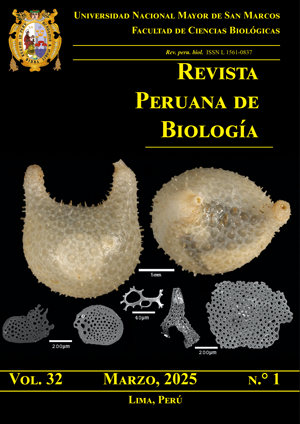New record of the boxelder bug Boisea trivittata in Argentina suggests a rapid spread
DOI:
https://doi.org/10.15381/rpb.v32i1.28983Keywords:
Alien species, Invasive species, Rhopalidae, Chinche del MapleAbstract
This study documents the presence of the boxelder bug Boisea trivittata (Say, 1825) (Hemiptera: Rhopalidae) in the city of San Juan, Argentina. In May 2024 (austral autumn), twelve specimens of B. trivittata were identified and deposited in the collection of the Institute of Basic Sciences at the National University of San Juan. This species, native to North America, is not considered a pest in its native range, and its introduction to South America was first reported in Santiago, in 2020. Our record adds to the first report of the species in Argentina, documented in the city of Mendoza in April 2024. This study provides relevant information on the species and discusses potential management strategies.
Downloads
References
Aguirre Zapata E, García Tirado JF, Morales Gonzalez H, Di Sciascio FA, Amicarelli AN 2022. Methodology for modeling and parameter estimation of the growth process of Lobesia botrana. Revista Iberoamericana de Automática e Informática Industrial 20, 68–79. https://doi.org/10.4995/riai.2022.17746
Carrizo Páez R, Pickenhayn, J, Carrizo Páez M. 2008. Urban Chagas Disease in San Juan. Diagnosis, Review, and Proposal for an Integrated Attack System. Revista Argentina de Cardiología 76(6): 480–487.
Carroll SP. 2020. Soapberry bugs of the World. Online (accessed on 16/5/2024). http://soapberrybug.org/
Carroll SP, Loye JE. 2012. Soapberry bug (Hemiptera: Rhopalidae: Serinethinae) native and introduced host plants: biogeographic background of anthropogenic evolution. Annals of the Entomological Society of America 105(5): 671–684. https://doi.org/10.1603/AN11173
Chopra NP. 1967. The higher classification of the family Rhopalidae (Hemiptera). Transactions of the Royal Entomological Society of London 119(12): 363–399.
Duboscq-Carra VG, Fernandez RD, Haubrock PJ, Dimarco RD, Angulo E, Ballesteros-Mejia L, Diagne C, Courchamp F, Nuñez MA. 2021. Economic impact of invasive alien species in Argentina: a first national synthesis. NeoBiota 67: 329–348. https://doi:10.3897/neobiota.67.63208
Faúndez E. 2023. a. Actualización de la distribución de Boisea trivittata (Say, 1825) (Heteroptera: Rhopalidae) en Chile. Revista Chilena de Entomología 49(3):495–498. https://doi.org/10.35249/rche.49.3.23.09
Faúndez E. 2023. b. La chinche del arce Boisea trivittata (Say, 1825) en Chile: ¿Inofensiva, dañina; o un problema en ascenso?. Revista Chilena de Entomología 49(1): 43–45. https://doi.org/10.35249/rche.49.1.23.06
Faúndez E, Carvajal AM, Sarmiento C. 2020. Detection of the boxelder bug Boisea trivittata (Say, 1825) (Heteroptera: Rhopalidae) in Chile. Heteroptera Poloniae - Acta Faunistica 14:125-126. http://doi.org/10.5281/zenodo.3934435
Faúndez E, Carpintero DL, Leiva F. 2024. Primera detección en Argentina y nuevos registros en Chile de Boisea trivittata (Say, 1825) (Heteroptera: Rhopalidae: Serinethinae). Acta Zoológica Lilloana 68(1):83–87. https://doi.org/10.30550/j.azl/1909
Hoebeke ER, Wheeler AG. 1982. Rhopalus tigrinus (Brachycarenus), recently established in North America, with a key to the genera and species of Rhopalidae in eastern North America (Hemiptera: Heteroptera). Proceedings of the Entomological Society of Washington 84(2): 213–224.
Houseman RM, Barrett BA. 2008. Boxelder bug. Home and garden. (accessed on 16/5/2024). Online at https://mospace.umsystem.edu/xmlui/bitstream/handle/10355/51180/g7360-2008.pdf?sequence=1
Knowlton GF. 1951. Boxelder Bug Damage to Crops, Journal Economic Entomology 44(6): 994 https://doi.org/10.1093/jee/44.6.994
Kottek M, Grieser J, Beck C, Rudolf B, Rubel F. 2006. World Map of the Köppen-Geiger climate classification updated. Meteorologische Zeitschrift 15(3): 259–263. http://doi: 10.1127/0941-2948/2006/0130
Mampe CD. 1972. The relative importance of household insects in the United States. Pest Control 40(12): 24: 26–27.
Martinez Carretero EE. 2022. Árboles del bosque urbano de Mendoza y San Juan. Guaymallén, Mendoza, Argentina.
Mehta SV, Haight RG, Homans FR, Polasky S, Venette RC. 2007. Optimal detection and control strategies for invasive species management. Ecological Economics 61(2–3): 237–245. https://doi.org/10.1016/j.ecolecon.2006.10.024
Michailides TJ, Ogawa JM, Rice RE, Sanders RD. 1988. Association of the boxelder bug (Hemiptera: Rhopalidae) with epicarp lesion of pistachio fruits. Journal Economic Entomology 81(4): 1148–1151. https://doi.org/10.1093/jee/81.4.1148
Ovruski SM, Schliserman P. 2012. Biological Control of Tephritid Fruit Flies in Argentina: Historical Review, Current Status, and Future Trends for Developing a Parasitoid Mass-Release Program. Insects. 3(3):870–888. https://doi.org/10.3390/insects3030870
Pall JL, Coscarón MDC. 2012. The Rhopalidae (Hemiptera: Heteroptera) of Argentina. Journal of Natural History 46(23–24):1441–1465. https://doi.org/10.1080/00222933.2012.673643
Plat C, Gallo P. 2023. Censo nacional agropecuario, resultados definitivos. Ciudad autónoma de Buenos Aires: Instituto Nacional de Estadística y Censos; 747pp
Reinert JA, Knauf TA, Maranz SJ, Bishr M. 1999. Effect of Beauveria bassiana fungus on the boxelder and red shouldered bugs (Hemiptera: Rhopalidae). Florida Entomologist 82(3): 469–474. https://doi.org/10.2307/3496873
Schaefer CW, Panizzi AR. 2000. Heteroptera of Economic Importance. Florida, United States of America.
Wheeler AG. 1982. Bed bugs and other bugs., In A. Mallis, (ed.) Hand-book of Pest Control. Franzak and Foster Co., Cleveland, Ohio. Pp. 313–345
Yoder KM. 1989. The ecology and management of the boxelder bug, Boisea trivittata (Say), (Hemiptera: rhopalidae) in the urban environment [Master of science in entomology]. Virginia: Virginia Polytechnic Institute and State University. http://hdl.handle.net/10919/50100
Downloads
Published
Issue
Section
License
Copyright (c) 2025 Juan Hector Aragon-Traverso, Eduardo Alfredo Sanabria

This work is licensed under a Creative Commons Attribution 4.0 International License.
AUTHORS RETAIN THEIR RIGHTS:
a. Authors retain their trade mark rights and patent, and also on any process or procedure described in the article.
b. Authors retain their right to share, copy, distribute, perform and publicly communicate their article (eg, to place their article in an institutional repository or publish it in a book), with an acknowledgment of its initial publication in the Revista Peruana de Biologia.
c. Authors retain theirs right to make a subsequent publication of their work, to use the article or any part thereof (eg a compilation of his papers, lecture notes, thesis, or a book), always indicating its initial publication in the Revista Peruana de Biologia (the originator of the work, journal, volume, number and date).






